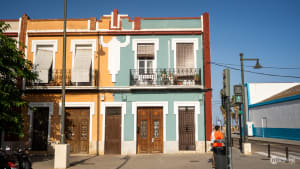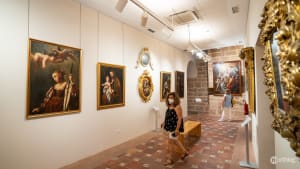
Ofrenda de Flores
Falleras and falleros flock to Plaça de la Mare de Déu in Valencia for a spectacular flower offering to the Patron Saint of the city, the Virgin of the Forsaken.
Ofrenda de Flores in a nutshell…
The Ofrenda de Flores is one of the most emotional and visually stunning events of Fallas, where falleras and falleros parade through Valencia to offer flowers to the city’s patron saint, the Virgin of the Forsaken. Over two days, thousands of bouquets are arranged to create a spectacular floral mantle for a 15-meter-tall statue in Plaza de la Virgen.
Location: Plaza de la Virgen (Plaça de la Mare de Déu)
Dates: March 17th & 18th
Time: 3:30 PM - 1:00 AM (each group has a set schedule)
Best viewing time: After dinner (around 9 - 10 PM), when most groups arrive at the square
Atmosphere: Live marching bands, traditional dresses, and a moving spectacle for both participants and spectators
On the eve of the fallas’ Cremà, falleros and falleras of Valencia pay a colourful tribute to the city’s patron saint with an Ofrenda de Flores (Ofrena de Flors in Valencian, Flower Offering in English). For two days, the committee members parade all over the city’s streets in their traditional dresses, each of them carrying flowers intended for the Virgin.
Their final destination is Plaza de la Virgen, also known as Plaça de la Mare de Déu. Here, they leave their flower offerings - hence the name of the event - to a massive wooden reproduction of the Virgin. Volunteers then climb on the structure to arrange the flowers into a design –kept secret every year– on the Lady’s mantle.

This feat, which takes 17 tonnes of flowers and two days to finish (the 17th and 18th of March), is dismantled three or four days after the end of the Fallas festival. In the meantime, locals can go and enjoy this grand and striking sight.
This event is one of the most emotional in the festival. In fact, it is not uncommon to see the various falleras and falleros moved to tears as they approach the square to pay their homage. On these two days, all the Fallas committees come together and participate in this pilgrimage of sorts, which anticipates the Cremà of the fallas, and therefore the end of another cycle.
For visitors, the event also becomes a chance to see all the amazing traditional fallera and fallero costumes, enjoy the music played by the marching bands, and try to guess what the design on the Virgin’s gown will be.
Schedule and Route
As the Ofrenda is a large parade that unfolds over two days, committees (there are 392 in Valencia) are assigned a specific time, day, and route to take.
Each group sets off from their falla and slowly makes its way to the Plaza de la Virgen, meaning that some committees have to walk several kilometres to get to their final destination.
Schedule
| Day |
|---|
| 17th March |
| 18th March |
Normally, the Falleras Mayores close the parades. The Fallera Mayor Infantil and her Corte de Honor pay homage to the Virgin on the 17th, while the Faller Mayor and her Corte de Honor go on the 18th.
Routes
There are usually two routes that the committees follow once in the city centre, but they can differ slightly every year. In any case, they will always end up in Plaza de la Virgen (also known as Plaça de la Mare de Déu), in front of the Basilica de la Virgen de los Desamparados.
The first route goes from Calle de la Paz to Calle Luís Vives ontoCalle Avellanas, then Calle Palau and Calle Almoina.
The second route instead comes from the west, starting in Calle de Quart, then Calle de Caballeros and then still straight on to Plaza Manises and Plaza de la Virgen.
The Virgin’s Statue
The Virgen de los Desamparados (Virgin of the Forsaken, in English) is the patroness of Valencia, to whom the Basilica in Plaça de la Mare de Déu and the Ofrenda de Flores itself are dedicated. On the occasion of the Fallas’ Offering, a 15 metres (about 49 feet) tall statue in the likeness of the Virgin is built and put in the square.
She appears with lily blossoms and a rose in one hand and baby Jesus in her other arm. Her gown is to be covered with the flowers offered by the falleros. She is generally depicted looking down, and her posture is slightly tilted forward. This has earned her the affectionate name of Geperudeta (or Jorobadita) de Valencia, meaning the little hunchback of Valencia.

If the year is particularly hot and sunny, you’ll also see that a huge canopy will be hung from one side to the other of the square. This is to keep the flowers in the shade and to prevent them from wilting.
The Message Hidden In the Dress
For every Fallas edition, about 50,000 bouquets are offered to the Virgin of the Forsaken in Plaça de la Mare de Déu, for a total of about 17 tonnes of flowers. As the falleras and falleros get to the square, they will leave the flowers in the hands of the vestidores, who will arrange them onto a structure in the image of the Virgin. Thus, they will make up a colourful mantle whose design is different and kept secret every year.
The motifs, designed by the vestidores, are instead revealed little by little as the participants offer their bouquets. The image generally bears a symbolic meaning regarding recent events. In 2022, for example, the design was that of a phoenix, signifying the rebirth of the festival after two difficult years of pandemic.
The Guidelines
This tradition of a secret image has been around since the 1990s, when a premeditated design was first introduced. Ever since then, the techniques have improved and new guidelines have been established.
For example, any thorns or hooks in the bouquets must be removed, so that the workers don’t get hurt. Cellophane paper is also forbidden since it can become slippery and hard to see on the ground.
To ensure the success of the design, the flowers used are carnations (they last the longest), with red and white being the most popular colours. The Junta Central Fallera tasks each committee with a specific colour to make sure that the right ratio is respected.
Los Vestidors
The vestidors (or vestidores, in Spanish) are the men and women who volunteer every year to design and dress the Virgin’s mantle in spectacular designs. There are about 50 of them, of all ages between 16 and 60 years old. The more experienced among them, who usually take care of making the outline of the design, are also called bordadores.
When the first Virgin mantle was instituted in 1987, the vestidores were a small group of friends, mostly with lifeguarding and mountaineering experience, which they needed to be able to climb up the 15-metre (about 49 feet) structure to hang the flowers. Slowly, the tradition was passed from parents to children, the group expanded, and their craft was perfected.

Nowadays, this still remains a work of passion and devotion to them. The rest of the year they all have regular jobs, some of them as taxi drivers, some as nurses, and some are even retired.
Origins of the Ofrenda
The Ofrenda, one of the most cherished rituals of the Fallas festival, has humble beginnings dating back to 1940s Valencia. What started as a spontaneous gesture of devotion by the Fallera Mayor and festival representatives soon grew into an enduring tradition.
Over the years, the offering evolved from simple floral tributes to an elaborate, large-scale event that required adjustments to accommodate its increasing popularity.
March 1940 - First offering
The origins of this tradition date back to Francoist Spain , in the 1940s. Apparently that year the Fallera Mayor and the festival representatives spontaneously decided to go make a small offering to the Virgin (patron saint of Valencia) on Saint Joseph’s day.
March 1941 - The Clabariersas’ offering
Inspired by the previous year’s offering, some clavariesas, followed by local girls dressed in farm clothes and mantillas, left flower bouquets to the Virgin in the Basilica.
March 1945 - Official offering
The tradition grew and cemented itself so much that in 1945 it was incorporated as an official act of Fallas.
1949 - First Ofrenda in the square
That year, the Ofrenda had to be moved outside the Basilica due to the large number of participants.
1965 - Two days of Ofrenda
Again to accommodate the growing number of people, authorities decided that the offering should be made over the course of two days (17th and 18th of March).
1987 - First Virgin statue
The Junta Central Fallera commissioned José Azpeitia to build the first Virgin bust to be decorated with flowers. This tradition has since been upheld, and the flowers form a new colourful tapestry on the Virgin’s gown every year.
Religious Sentiment
This really is the only religious event of an otherwise non-religious festival, one that is arguably of pagan origin. Even though the offering remains religious at its core, many people simply go to honour a tradition and enjoy the atmosphere of joy and great emotion.
The spectacle of the Virgin’s gown being completed also attracts a large public regardless of their religious inclinations.
Frequently Asked Questions
Here you can find quick answers to all of your questions. Linked, you’ll find the articles or the sections of the articles that can give you more detailed information.
-
The Ofrenda de Flores is a flower offering to honour the patron saint of Valencia, the Virgin of the Forsaken. For two days, falleros and falleras parade all over the city’s streets in their traditional dresses. Each of them carries flowers that will end up decorating a huge statue of the Virgin, located in Plaça de la Mare de Déu.
-
The parade for the Ofrenda de Flores takes place every year on the 17th and 18th of March, starting at 3:30 pm and ending at around 1:00 am. To see the falleras and falleros arrive at the square, we suggest you get there after dinner.
-
The massive statue of the Virgin that is going to be covered in flowers is in Plaza de la Virgen (also known as Plaça de la Mare de Déu), in front of the Basilica de la Virgen de los Desamparados. To get there, the committees usually follow two routes. If you’d like to know more about the routes, you can have a look at the relevant section of this article.
-
Yes, it is religious at its core - it is an offering to honour the Virgin of the Forsaken. However, many people simply go in the spirit of tradition and to enjoy the atmosphere of joy and great emotion.
-
No, even though there are a number of Christian-adjecent traditions - like the Ofrenda itself. In fact its origins can arguably be considered pagan.
-
The point of the Ofrenda is to honour the patron saint of Valencia - the Virgin of the Forsaken - and to ask her for a good end to the Fallas.
-
Each Fallas committee belonging to the Junta Central Fallera participates.
-
Yes, every year each Fallas committee is assigned a time and route to walk for their offering to the Virgin. This ensures a beautiful procession over the course of two days in Valencia. If you’d like to know more about the routes, check out the relevant section of this article.
-
The vestidors (or vestidores, in Spanish) are the men and women who volunteer every year to design and execute the Virgin’s mantle. There are about 50 of them, of all ages between 16 and 60 years old.
If you’d like to know more about them, check out the relevant section of this article.
-
The clavariesas are the ladies dressed in black who follow the saints’ statues in processions. You can still see them today all over Spain during religious events. Although they are often credited with starting the Ofrenda’s tradition, it seems like it was a Fallera Mayor who first offered the flowers on Saint Joseph’s day.
-
The design, which is kept secret until the last minute, is usually representative of the year that just passed. If you’d like to know more about the hidden message in the Virgin’s mantle, you can check out the relevant section of this article.
-
The vestidors are in charge of designing the motif and arranging the flowers on the Virgin’s mantle every year.
If you’d like to know more about the design, check out the relevant section of this article.
-
Every year, around 50,000 bouquets are used to decorate the Virgin’s mantle. That’s about 17 tonnes of flowers.
-
Yes, the flowers used are normally carnations (the most popular colours are red and white, but other colours can be used too). This is because of their durability and shape.
If you’d like to know more about the types of flowers used and how the colours are assigned to each group, you can read the relevant section of this article.



















